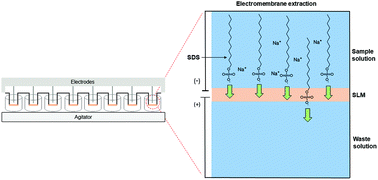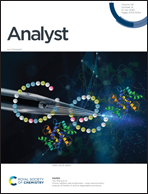Electromembrane extraction of sodium dodecyl sulfate from highly concentrated solutions
Abstract
This fundamental work investigated the removal of sodium dodecyl sulfate (SDS) from highly concentrated samples by electromembrane extraction (EME). SDS concentrations were in the range of 0.1–1.0% w/v, covering both sub- and super-critical micellar concentrations (CMC). Under optimal conditions, we extracted SDS from 100 μL aqueous sample, through 3 μL supported liquid membrane (SLM) and into 200 μL 10 mM NaOH in water as waste solution. The SLM comprised 1.0% w/w Aliquat 336 in 1-nonanol, and extraction voltage was 5 V. From 0.1% SDS samples, EME removed 100% during 30 minutes operation (100% clearance). SDS concentration above the critical micellar concentration (CMC) challenged the capacity of the system. Thus, to reach 100% clearance from 0.5% samples, we extracted for 120 minutes and replenished the SLM after 60 minutes. Increasing the membrane area of the SLM from 28 mm2 to 43 mm2 provided 100% clearance from 0.5% samples after 30 min EME. Complete clearance of 1.0% SDS samples was not achieved under the tested conditions, and maximal clearance was 60%. Mass balance experiments demonstrated that most of the removed SDS is trapped in the SLM, rather than transferring to the waste solution. For super-CMC samples, aggregation of SDS in the SLM exceeded the SLM capacity and impeded further mass transfer.



 Please wait while we load your content...
Please wait while we load your content...